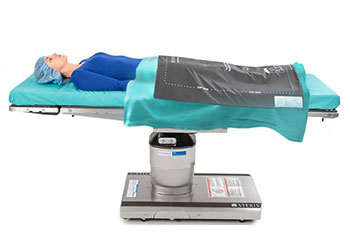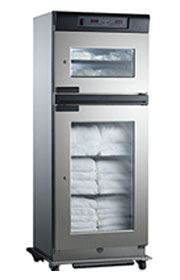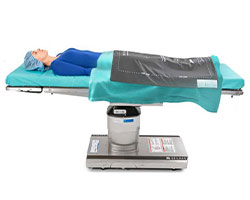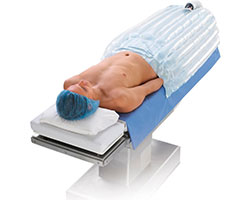Importance of Perioperative Patient Warming

Too many patients experience some form of unplanned perioperative hypothermia in which their core body temperature drops below 96.8° F during surgery. A drop in core body temperature can lead to adverse patient outcomes such as myocardial events, infections, poor incision healing, postoperative pain, and increased blood loss.
Patient Warming Systems can be used to manage the warming protocol to help to mitigate the risk of perioperative hypothermia for surgical patients.
In this article, you will learn:
- What is patient warming
- Why warmth matters before, during, and after surgery
- Is hypothermia common after surgery?
- How long does hypothermia last after surgery?
- How can perioperative hypothermia be prevented?
- What are the AORN guidelines for patient warming?
- What are methods to warm a patient?
- What devices are used for patient warming?
What is patient warming?
Patient Warming uses active warming devices and passive warming measures to maintain the patient normothermia, in which a patient’s body is at its normal core temperature of 98.6°F (37°C). This includes providing heat to the patient before, during, or after procedures in the Operating Room (OR).
Why warmth matters before, during, and after surgery?
A patient’s normothermic temperature is a critical vital sign that needs to be sustained throughout the three phases of a surgical procedure. This includes preoperative, intraoperative, and postoperative care.
Normally, normothermic patients experience mild hypothermia during the different phases of a surgical procedure, but the goal of any perioperative team is to mitigate this risk.
Why do you need to warm patients before surgery?
When a patient is not pre-warmed prior to being transferred to the OR, an active warming device should be started as soon as possible when the patient arrives in the OR. The biggest concern is waiting too long to get the treatment started. Maintaining a patient’s normothermia is much easier than regaining the body temperature lost to hypothermia. This is why early and frequent monitoring and treatment are important.
Benefits of warming patients before surgery:
-
Decreased Risk for Surgical Site Infections (SSIs)
While some of the data is still inconclusive, a study by Kurz et al3 determined that patients with a body temperature 2°C lower than normal had three times the susceptibility to contracting an SSI during the surgical procedure.
-
Increased Patient Blood Loss
Studies have concluded that mild hypothermia (36°-37°C) can contribute to a significant increase in blood loss by 16%4. In addition, mild hypothermia can also slow the blood’s coagulation process. This adds to the time it takes for a patient’s wounds or incision to heal and in turn slows down their recovery.
-
Extended Hospital Stays
Some studies have indicated that extended hospital stays are indicative of patients that experience untreated perioperative and postoperative hypothermia. Side effects of hypothermia included a patent’s inability to tolerate food after a surgical procedure. In some situations, once the hypothermic effect was corrected, an extra day of stay in the hospital was required to mitigate the chance of infection.
-
Patient Discomfort
While most findings of hypothermia studies of hyperthermia on surgical patients focus on direct outcomes for the patient’s health, there has also been a correlation to the patient’s peri and postoperatively comfort. Mildly hypothermic patients often complain of discomfort, which may be reflected in patient satisfaction surveys conducted post-recovery.
Why is it important to keep patients warm during surgery?
Anesthesia exposure is associated with 80% of heat loss in surgical patients, this is why it is important to implement active warming methods on hand and keep the patient normothermia, as these are the only methods that counter the effects of anesthesia.
What is postoperative hypothermia?
When the patient’s temperature drops below 96.8°F (36° C) they are considered hypothermic and must be addressed to maintain their normothermic temperature. The drop in temperature could be due to induction of anesthesia, patient skin exposure for long hours, or other Operating Room environment factors.
How can perioperative hypothermia be prevented?
To mitigate the negative outcomes of hypothermia on a surgical patient, AORN recommends that hospitals implement methods for treating hypothermia for all patients during perioperative care. This includes:
- Assessing Every Patient Preoperatively
- Monitoring the Patient Throughout Intraoperative Care
- Managing Core Body Temperature Postoperatively
What are the AORN guidelines for patient warming?
AORN states that all perioperative patients are at risk for developing hypothermia. The perioperative team is responsible for properly monitoring their patients’ normothermic core temperature of 98.6°F (37° C) pre, intra, and postoperatively. Patients with a temperature of 96.8°F (36° C) or below are considered mildly hypothermic and must be addressed to maintain their normothermic temperature.
If the perioperative team does not address hypothermia early in the process, several factors can negatively impact the patient.1
What are the methods to warm a patient?
To mitigate the negative outcomes of hypothermia on a surgical patient, AORN recommends that hospitals implement methods for treating hypothermia for all patients during perioperative care. This includes:
- Active warming methods: which would include a patient warming system that externally warms a patient’s body.
- Passive warming methods: which would include the use of warmed blankets and IV fluids
What devices are used for patient warming?
Warming Cabinets:
 While not used as an active patient warming system, the warming cabinet does provide two options for passive warming which include:
While not used as an active patient warming system, the warming cabinet does provide two options for passive warming which include:
- Blanket warming
- IV solutions and irrigation fluid warming
AORN recommends that hospital staff conduct a risk assessment and consult manufacturers' IFUs to establish appropriate warming temperatures for blankets and fluids to ensure patient safety.
Warmed blankets have been used by perioperative teams for years to help support a patient’s comfort prior to and after a surgical procedure. While the warmed blankets can support a patient’s comfort, the overall effect they can have on a mildly hypothermic patient can often be minimal due to the temporary warmth they provide.
Browse STERIS Warming Cabinets
 Conductive Patient Warming Systems: for active patient warming. These systems use a heated surgical table pad and optional over-body blanket immediately upon transfer to the surgical table to provide heat to the patient before, during, or after procedures in the Operating Room. STERIS Patient Warming System uses conductive heat transfer through direct contact between the patient, the surgical table pad, and the over-body blanket.
Conductive Patient Warming Systems: for active patient warming. These systems use a heated surgical table pad and optional over-body blanket immediately upon transfer to the surgical table to provide heat to the patient before, during, or after procedures in the Operating Room. STERIS Patient Warming System uses conductive heat transfer through direct contact between the patient, the surgical table pad, and the over-body blanket.
 Forced-air warmers: These systems consist of an inflatable blanket and a warming unit connected via a flexible hose. The patient is warmed by placing the blankets over or under the patient. When the unit is turned on, warmed air is passed through the interior of the blanket. The inflatable blankets are for single use only.
Forced-air warmers: These systems consist of an inflatable blanket and a warming unit connected via a flexible hose. The patient is warmed by placing the blankets over or under the patient. When the unit is turned on, warmed air is passed through the interior of the blanket. The inflatable blankets are for single use only.
While all marketed systems can support active warming for surgical patients, recent studies raise concerns. Some studies suggest that the forced air technology in the Bair Hugger Normothermia System has the potential to circulate airborne contaminates close to the surgical site due to its use of forced air.2
Contributors

Lena Fogle BSN, RN, CNOR
Senior Director Global Clinical Solutions, STERIS Healthcare

Lena is a seasoned healthcare leader with extensive experience leading complex perioperative environments as well as new program development, continuous process improvement, clinical outcomes, operational excellence, and stakeholder experience.
References
1 AORN Guidelines: https://www.aornguidelines.org/guidelines/content?sectionid=173731777&view=book#221440313
2 Effect of forced-air warming on the performance of operating theatre laminar flow ventilation: https://pubmed.ncbi.nlm.nih.gov/22321079/
3 Sessler DI. Temperature monitoring and perioperative thermoregulation. Anesthesiology 2008;109:318–38.
[PMC free article] [PubMed] [Google Scholar]
4 H. Schmied et al. Mild intraoperative hypothermia increases blood loss and allogeneic transfusion requirements during total hip arthroplasty
 United States
United States
 Canada (EN)
Canada (EN) Canada (FR)
Canada (FR) Deutschland
Deutschland Italia
Italia United Kingdom
United Kingdom Australia
Australia New Zealand
New Zealand Singapore
Singapore Brasil
Brasil México
México

 While not used as an active
While not used as an active  Conductive Patient Warming Systems: for active patient warming. These systems use a heated surgical table pad and optional over-body blanket immediately upon transfer to the surgical table to provide heat to the patient before, during, or after procedures in the Operating Room.
Conductive Patient Warming Systems: for active patient warming. These systems use a heated surgical table pad and optional over-body blanket immediately upon transfer to the surgical table to provide heat to the patient before, during, or after procedures in the Operating Room.  Forced-air warmers: These systems consist of an inflatable blanket and a warming unit connected via a flexible hose. The patient is warmed by placing the blankets over or under the patient. When the unit is turned on, warmed air is passed through the interior of the blanket. The inflatable blankets are for single use only.
Forced-air warmers: These systems consist of an inflatable blanket and a warming unit connected via a flexible hose. The patient is warmed by placing the blankets over or under the patient. When the unit is turned on, warmed air is passed through the interior of the blanket. The inflatable blankets are for single use only.

